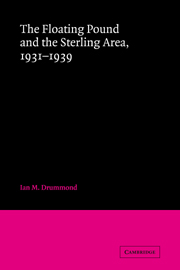Book contents
- Frontmatter
- Contents
- Preface
- 1 Introduction: the sterling area in the 1930s
- 2 Sterling and the rupee
- 3 The Canadian debate over money and exchanges, 1930–1934
- 4 South Africa, sterling, and the gold standard, 1931 and thereafter
- 5 Australia and New Zealand, 1930–1939
- 6 Monetary preparations for the World Economic Conference
- 7 United Kingdom policy at the World Monetary and Economic Conference
- 8 Talking about exchange stabilization, autumn 1933 through June 1936
- 9 The Tripartite Agreement of 1936
- 10 Intergovernmental conversations and the management of sterling, 1936–1939
- 11 Conclusion: the significance of sterling
- Notes
- Index
9 - The Tripartite Agreement of 1936
Published online by Cambridge University Press: 07 October 2011
- Frontmatter
- Contents
- Preface
- 1 Introduction: the sterling area in the 1930s
- 2 Sterling and the rupee
- 3 The Canadian debate over money and exchanges, 1930–1934
- 4 South Africa, sterling, and the gold standard, 1931 and thereafter
- 5 Australia and New Zealand, 1930–1939
- 6 Monetary preparations for the World Economic Conference
- 7 United Kingdom policy at the World Monetary and Economic Conference
- 8 Talking about exchange stabilization, autumn 1933 through June 1936
- 9 The Tripartite Agreement of 1936
- 10 Intergovernmental conversations and the management of sterling, 1936–1939
- 11 Conclusion: the significance of sterling
- Notes
- Index
Summary
In the last chapter, we saw that the years 1933–6 were littered with Franco-American initiatives in the matter of exchange rates. Throughout these years, Chamberlain's position was consistent: The pound would not be artificially devalued, but neither would it be pegged to gold or to the dollar until the world had been freed of the trading and financial barriers that had made the old gold standard unworkable. In public and in private he and his officials put forward this view. Behind the scenes British policy makers were more divided. Leith-Ross and the Bank continued to hanker after a fixed exchange rate, whereas Phillips and the chancellor were persuaded that it was unsafe to imperil the domestic cheap-money policy by committing the country to a fixed rate. Further, it is possible to assert that through the Exchange Equalisation Account the pound was being kept below its market value. Certainly the Account and the Bank were accumulating gold. On the other hand, the authorities knew that sterling balances were also accumulating, and they were aware that hot money was flowing into the London market. In these conditions, it may be argued, they were right to strengthen their gold reserves. If this claim is granted, Chamberlain and his officials were correct in stating that the pound was not being depreciated artificially. As for the internal disputes about a fixed rate, neither the French officials nor the Americans were made aware of these differences, though perhaps they were known to American and French central bankers.
- Type
- Chapter
- Information
- The Floating Pound and the Sterling Area1931–1939, pp. 201 - 222Publisher: Cambridge University PressPrint publication year: 1981



